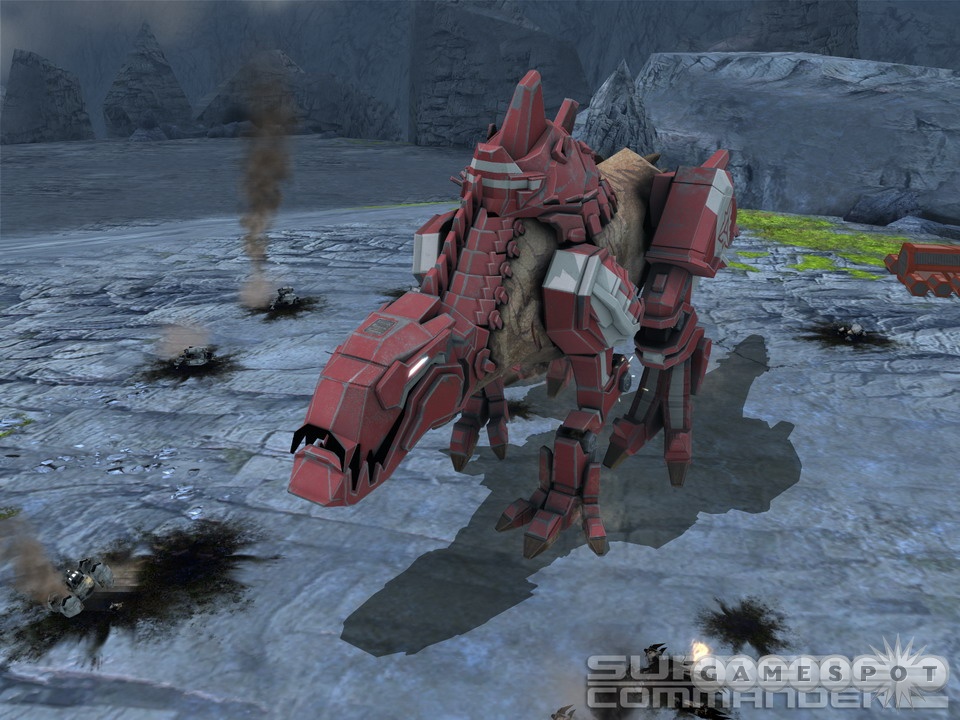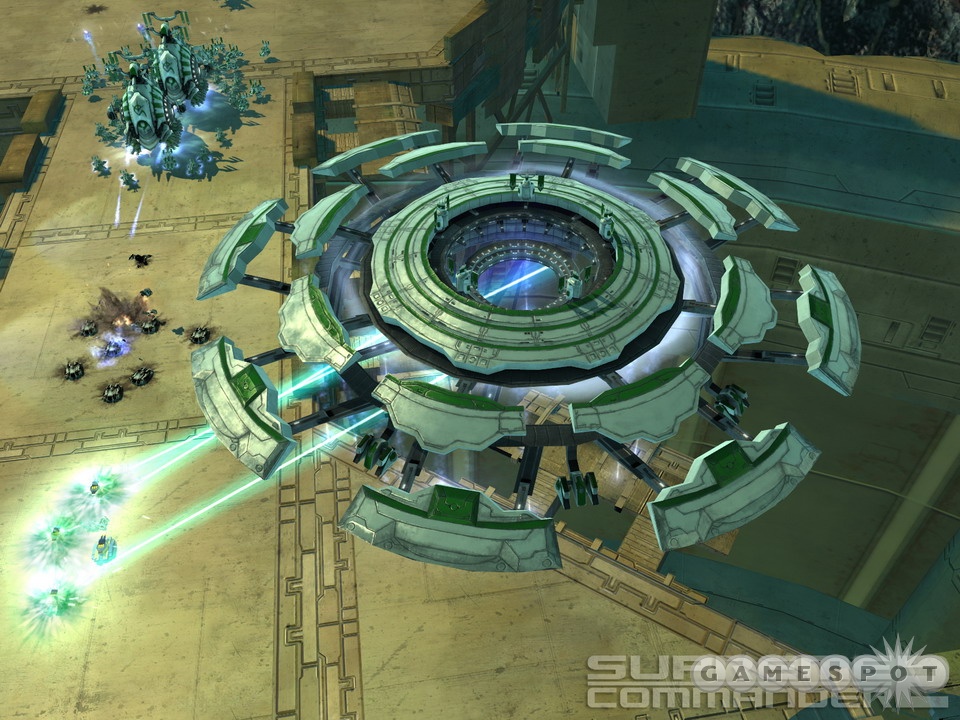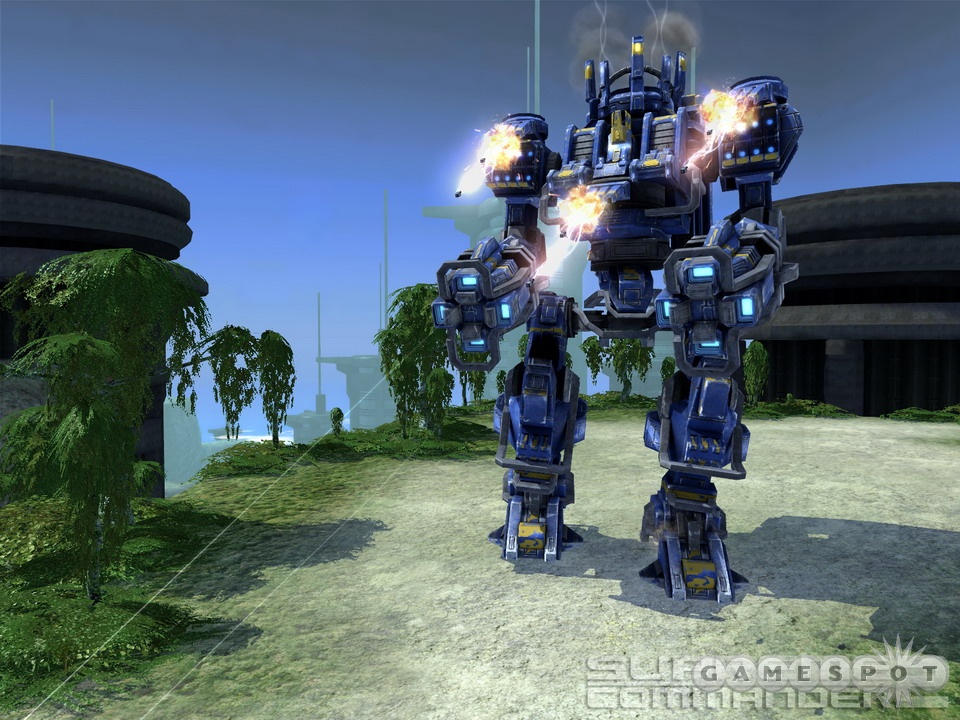Supreme Commander 2 Updated Hands-On - Single-Player, Early Strategies, Unit Mix
We try out some single-player gameplay, as well as cover the campaign and some of the powerful units in this epic strategy sequel.
Supreme Commander 2 will be bigger, faster, and filled with even more giant death robots than the previous game. The sequel will--like the original Supreme Commander (and its inspiration, Total Annihilation)--still focus on higher level strategy and smart planning along specific research lines to improve and expand your armies. But it will also have a streamlined resource model to get you into the action faster, as well as intricate branching research trees that will let you build up an army of many different kinds of killer robots to wipe your opponents off the face of the planet by land, sea, or air. We have new details to discuss about the game's single-player campaign, early game strategies, and powerful military units to share. Please be advised that this article may contain spoilers.
Starfield May Update LEGO Fortnite | Star Wars Rebel Adventure Cinematic Trailer Disney Dreamlight Valley – Thrills & Frills Update Trailer Apex Legends - Official Alter Legend Animated Reveal Trailer | "Based on a True Story" Batman: Arkham Shadow | Official Cinematic Teaser Trailer Mullet MadJack - Official Gameplay Trailer EARTH DEFENSE FORCE 6 - Official Release Date Reveal Trailer Street Fighter 6 - Akuma Arrives! Fighting Pass Reveal Trailer SMT V: Vengeance Is Much Bigger Than You Think Which Fallout Game You Should Play First Funko Fusion - Official Reveal Trailer Star Wars: Hunters -Official Launch Date Reveal Cinematic Trailer
Please enter your date of birth to view this video
By clicking 'enter', you agree to GameSpot's
Terms of Use and Privacy Policy
As we've mentioned previously, Supreme Commander 2's campaign will, like the original game, consist of 18 "operations," (essentially, missions, though each will take place on an enormous map that will expand in size as the action continues), divided into six operations per faction. The first six operations will tell the tale of Commander Dominic "Migraine" Maddox, an officer in the UEF faction--the faction that has assumed control of the intergalactic coalition between it and the game's two other factions. Maddox is an accomplished military man whose father fought through the Infinite War of the previous game. But he was able to put aside his differences when he met his bride to be, a young woman belonging to the Illuminate faction. Just before Supreme Commander 2 begins, Maddox becomes a father, and his wife Annika cares for their son on a faction-neutral planet while struggling to keep her identity and religion a secret. By the time the game begins, Maddox himself has become a world-weary veteran looking for a way to retire from the military to live out a peaceful life with his new family.
The subsequent campaign operations are devoted to the Illuminate and Cybran protagonists of Supreme Commander 2. In the Illuminate campaign, you'll play as Commander Thalia Kael who is a member of a powerful Illuminate splinter faction known as the Royal Guardians and who actually attended military training at the same academy as Maddox. Her motivation is to restore the original Aeon faction (which had been led by the lost princess Rhianne Burke) to power following the bloody war with the Seraphim alien race. Thalia's mission is to secretly aid the Royal Guardians in seizing power back from the Illuminate with the guidance of her older brother Jaran. Thalia's brother is a former military officer retired due to chronic illness who now relays orders and strategic advice to his sister remotely.
The final set of operations tells the story of Commander Ivan Brackman, the "son" of Dr. Gustav Brackman--the latter of which is the leader of the Cybran faction and no more than a superintelligent, preserved brain in a jar. Ivan is the first of a new breed of Cybran--perfect hybrids of human tissue and cybernetic technology. And by virtue of his more-human physiology, he's been known to exhibit more independent thought than the average Cybran. Having expressed interest in military operations at an early age, he was sent to the same academy that Maddox and Thalia attended. But he took a different path after graduation and was recruited by Dr. Brackman himself to join his father's personal defense force.
While the story of the game's campaign is much more intimate and tied to human relationships than that of the original game, the sequel's basic gameplay will test your ability to be a calculating field general with the vision to commit to a long-term strategic plan, as well as the guts to press that big red button to initiate nuclear war if necessary. We had a chance to try out some skirmish maps against computer-controlled opponents with the game's three factions and found a much faster startup into a much more heated series of battles than in the original game.

In Supreme Commander 2's skirmish and multiplayer maps, you'll find yourself starting off with a single ACU unit and two engineers not that far off from some mass nodes. Your best bet is to build up some mass extractors as soon as possible, but beyond that, you're ready to make your first big strategic decision--which type of military installation to build. You can choose to build a land, air, or naval installation (though the Illuminate don't have a full naval track because their units hover over the ground and can cross water) to produce a few basic units that function on that particular terrain type.
On the PC, this takes place by way of a conventional mouse-and-keyboard interface that has been heavily streamlined to not dominate onscreen real estate. On the Xbox 360, the control scheme has been modified to work with the sticks and buttons, replacing the standard mouse cursor with a "stretch cursor" that will let you select any nearby unit with a quick button press rather than having to hunt for that unit and precisely click on it. (The console version of the game also lets you paintbrush any units in the vicinity to group-select them.) Though the console version has simple, one-button shortcuts for move and attack orders, Supreme Commander 2 uses a radial menu system to issue more complex orders, such as building structures in specific areas or queuing up specific units to build at an installation. While it took us a bit of time to get used to the interface, we quickly figured out the radial menu system and button shortcuts. Thus, we were able to pretty much do the same things we had done on the PC version.
On either platform, once you've built your first mass collectors and energy generators to get a basic economy going, as well as your first military installation to get your army going, you're ready to start climbing the technology tree. This means you're ready to start your quest to eventually unlock and bring out the big guns. But rather than upgrade an expensive town hall structure to unlock an additional "tier" of units, you can unlock advanced armies by way of research.

Research has five different tracks in Supreme Commander 2: land, air, naval (except for the Illuminate), ACU, and structure. Research accumulates automatically over time in a ticking meter that gets higher and higher during a match (you can also build research structures that speed up how quickly you gain research points). And with enough points, you can start spending it on any upgrade within the five tracks you can afford. Researchable items generally fall into three categories: unlocks (new units), upgrades (brand new abilities added to existing units), and boosts (miscellaneous bonuses, such as additional toughness or sight range). Exactly which of these alternatives will make the most sense to you will depend on the overall strategic decisions you make going into the game, as well as any intelligence you can glean about your opponent's development thought reconnaissance, which is another crucial component of the game.
The three primary military tracks (land, air, and naval) all seem to provide well-rounded, self-contained upgrades and unit unlocks. The Illuminate air track, for instance, unlocks gunships, transports, and fighter-bombers, as well as personal shield upgrades to ensure your air force can take it while dishing it out. The UEF land track includes rugged but sporty armor like the rock-head tank and demolisher artillery, as well as cumulative training upgrades that will make all land units in this military-minded faction tougher on the battlefield.
Though we spent only a limited time sitting down to play the game, we found ourselves quickly able to tech up to midlevel units in a matter of minutes and start raiding runs on our skirmish opponent's resource expansions. But we caught ourselves looking back and forth between our research counter and the next experimental unit upgrade on more than one occasion. Experimental units are embedded in each research tree and can be built after you've researched at least one and then constructed an experimental unit facility. These powerful additions to your army include minor experimental units (which are generally very powerful and a true threat when massed), such as gigantic unit transports for all three factions.
However, the glistening rewards waiting at the top of each research track are the major experimental units. These include such monstrosities as the Cybranasaurus Rex, the ultimate in Cybran land melee; the King Kriptor mech, a giant UEF robot made entirely out of enormous cannons; and the Illuminate Darkenoid, a humongous flying saucer that not only rains blazing death down on any land targets below it but whose enormous mass also crushes any unfortunate troops beneath it when it's shot down and comes crashing down to terra firma. Each of these major experimental units seems extremely satisfying to use, and once you see your enemy bring them into play, you know the battle has truly been joined. Even more interestingly, Supreme Commander 2 will give you the option to launch a partially constructed experimental unit in a "half-baked" state by pushing it out of the gate before it's 100 percent completed. A half-baked experimental unit will obviously be faster to mobilize, but it has a chance of mechanical failure based on how far along its construction was; a 70 percent complete unit has a 30 percent chance of failure, for instance. This new feature will let you roll the dice to make a desperate last stand against an enemy who's attacked you before you were fully prepared. Though in larger battles, we can see half-baked experimentals taking on an offense role as players who have more mass than time rush out a couple of experimentals to make an aggressive late-game push.
Even though each of the three primary military tracks offers extensive (and largely self-contained) upgrades, in matches against tougher opponents (such as the hard-difficulty artificial intelligence, which is an immaculately resource-efficient terror as of this writing), you may need to tech all the way up to the top of one research tree to deal your enemy a mortal blow. And in some cases, you may need to tech beyond that. That's where the remaining ACU and structure research trees also offer valuable support abilities. With research, the ACU unit becomes a much more valuable and flexible unit on the battlefield, which can not only flee from battle by ejecting an escape pod, enter "overcharge" mode to rain down heavy offensive fire, or "hunker" down into a defensive posture that greatly increases its armor--but it can also gain additional armor and damage upgrades that let it go toe-to-toe with major experimentals to actually win. In the meantime, structural research offers enhancements that speed your production and cut down on your mass and energy spending. This makes your overall operation more efficient and better able to churn out a continuous stream of units. Structure upgrades aren't as exciting as teching up to an enormous killer robot, but their value will become a lot more apparent to your opponent when you use a streamlined, upgraded production economy to keep pumping out enormous killer robots.

Judging from our time with the game, the sequel seems like it'll offer a strategy experience that's both fast paced and varied. While having fast fingers may help you squeeze out some better resources, it really seems like you're more likely to win the day with well-scouted recon to gauge your opponent's strategies and progress--balanced out against careful choices on your own research and army development. This is going to be a game where smart decision-making will lead to crushing your enemies on the battlefield with nuclear warheads and giant death machines. Supreme Commander will be released this March for the PC and Xbox 360--stay tuned to GameSpot for more updates.
Got a news tip or want to contact us directly? Email news@gamespot.com
Join the conversation